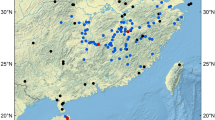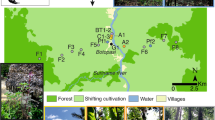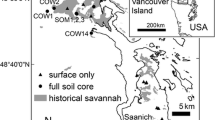Abstract
Changing rice and millet arable systems were closely linked to social and environmental changes in Neolithic and Early Bronze Age in Central China. Two methods are used here to distinguish between rainfed millet farming and rice farming, using phytoliths from crop weeds found in ash middens and mixed cultural layer contexts. Samples were taken from three sites, Xipo and Huizui, in the Yellow River Valley in Henan, and Baligang which is situated towards the south of the province. The samples are from three cultural phases, Yangshao, Longshan and Erlitou. The phytoliths used are from grass leaves, so are not identified to genera or species but rather grouped into ecological categories, and canonical correspondence analysis was applied. Next, the ratios were calculated of phytolith morphotypes from cells that are genetically predisposed to form phytoliths (fixed), compared to silica bodies from cells that will form silica bodies when there is sufficient water uptake (sensitive). The results show differentiation between millet and rice and differences in how wet the rice fields were. The region experienced social and climate change throughout this time and this is reflected in the results.





Similar content being viewed by others
References
An CB, Feng ZD, Tang L (2004) Environmental change and cultural response between 8000 and 4000 cal. Yr bp in the western Loess Plateau, northwest China. J Quat Sci 19:529–535
An CB, Feng Z, Barton L (2006) Dry or humid? Mid Holocene humidity changes in arid and semi-arid China. Quat Sci Rev 25:351–361
Bowdery D (2007) Phytolith analysis, sheep, diet and fecal material at Ambathala pastoral station (Queensland, Australia). In: Madella M, Zurro D (eds) Plants, people and places: recent studies in phytolith analysis. Oxbow Books, Oxford, pp 134–150
Chang KC (1983) Art myth and ritual. Harvard University Press, Cambridge
Crawford G (2009) Agricultural origins in North China pushed back to the Pleistocene–Holocene boundary. Proc Natl Acad Sci USA 106:7,271–7,272
Deng Z, Qin L, Gao Y, Weisskopf AR, Zhang C, Fuller D (2015) From early domesticated rice of the middle Yangtze Basin to millet, rice and wheat agriculture: archaeobotanical macro-remains from Baligang, Nanyang Basin, Central China (6700–500 bc). PLoS ONE. doi:10.1371/journal.pone
Dykoski CA, Lawrence Edwards R, Cheng H, Yuan D, Cai Y, Zhang M, Lin Y, Qing J, An Z, Revenaugh J (2005) A high resolution, absolute-dated Holocene and deglacial Asian monsoon record from Dongge Cave, China. Earth Planet Sci Lett 233:71–86
Eichhorn B, Neumann K, Garnier A (2010) Seed phytoliths in West African Commelinaceae and their potential for paleoecological studies. Palaeogeogr Palaeoclimatol Palaeoecol 298:300–310
Feng ZD, An CB, Tang LY, Jull AJT (2004) Stratigraphic evidence of a Megahumid climate between 10,000 and 4000 years bp in the western part of the Chinese Loess Plateau. Glob Planet Chang 43:145–155
Feng Z-D, An CB, Wang HB (2006) Holocene climatic and environment changes in the arid and semi-arid areas of China: a review. Holocene 16:119–130
Ford A (2004) Ground stone tool production at Huizui, China: an analysis of a manufacturing site in the Yilou River Basin. Bull Indo Pac Pre Hi 24:71–77
Fuller DQ, Qin L (2009) Water management and labour in the origins dispersal of Asian rice. World Archaeol 41:88–111
Fuller DQ, Stevens C (2009) Agriculture and the development of complex societies: an archaeobotanical Agenda. In: Weiss E, Fairbairn A (eds) Ethnobotanist of distant pasts: papers in honour of Gordon Hillman. Oxbow Books, Oxford, pp 37–57
Fuller DQ, Sato Y, Castillo C, Qin L, Weisskopf AR, Kingwell-Banham EJ, Song J, Ahn S, Van Etten J (2010) Consilience of genetics and archaeobotany in the entangled history of rice. Archaeol Anthropol Sci 2:115–131
Herzschuh U, Tarasov P, Wunnemann B, Hartmann K (2004) Holocene vegetation and climate of the Alashan Plateau, NW China, reconstructed from pollen data. Palaeogeogr Palaeoclimatol Palaeoecol 211:1–7
Hunt H, van der Linden M, Liu X, Motuzaite-Matuzeviciute G, Colledge S, Jones MK (2008) Millets across Eurasia: chronology and context of early records of the genera Panicum and Setaria from archaeological in the Old World. Veget Hist Archaeobot 17(Suppl 1):S5–S18
Jenkins E, Jamjoum K, Al Nuimat S (2010) Irrigation and phytolith formation: an experimental study. In: Black E, Mithen S (eds) Water, life and civilisation: climate, environment and society in the Jordan Valley. Cambridge University Press, Cambridge, pp 347–372
Jiang Q, Zhang J (1998) Phytolith evidence for rice cultivation during prehistoric periods at Baligang site of Baizhuang, Dengzhou City, Henan Province. Acta Scientiarum Naturalium Universitatis Pekinensis 34:66–71
Kealhofer L, Huang F, DeVincenzi M, Kim MM (2015) Phytoliths in Chinese foxtail millet (Setaria italica). Rev Palaeobot Palynol 223:116–127
Lee YK (2004) Control strategies and polity competition in the lower Yi-Luo Valley, North China. J Anthropol Archaeol 23:172–195
Lee G-A, Bestel S (2007) Contextual analysis of plant remains at the Erlitou-period Huizui site, Henan, China. Bull Indo Pac Pre Hi 27:49–60
Lee G-A, Crawford G, Liu L, Chen X (2007) Plants and people from the early Neolithic to the Shang periods in North China. Proc Natl Acad Sci USA 104:1,087–1,092
Liu L (1996) Settlement patterns, chiefdom, variability and the development of early states in north China. J Anthropol Archaeol 15:237–288
Liu L (2004) The Chinese neolithic: trajectories to early states. Cambridge University Press, Cambridge
Liu L, Chen X (2003) State formation in early China. Duckworth, London
Liu X, Hunt HV, Jones MK (2009) River valleys and foothills: changing archaeological perceptions of North China’s earliest farms. Antiquity 83:82–95
Lu T (2002) A green foxtail millet (Setaria viridis) cultivation experiment in the middle Yellow River Valley. Asian Perspect 41:1–14
Lu H, Zhang J, Wu N, Liu KB, Xu D, Li Q (2009) Phytoliths analysis for the discrimination of foxtail millet (Setaria italica) and common millet (Panicum miliaceum). PLoS ONE 4:e4448
Ma X (2005) Emergent Social complexity in the Yangshao Culture: analyses of settlement patterns and faunal remains from Lingbao, Western Henan, China. British Archaeological Reports, Oxford
Madella M, Alexandre A, Ball T, ICPN Working Group (2005) International Code for Phytolith Nomenclature 1.0. Ann Bot 96:253–260
Madella M, Jones MK, Echlin P, Powers-Jones A, Moore M (2009) Plant water availability and analytical microscopy of phytoliths: implications for ancient irrigation in arid zones. Quat Int 193:32–40
Metcalfe CR (1960) Anatomy of the Monocotyledons I. Gramineae. Oxford University Press, London
Moulia B (1994) The biomechanics of leaf rolling. Biomimetics 2:267–281
Parry DW, Smithson F (1964) Types of opaline silica depositions in the leaves of British grasses. Ann Bot 28(1):169–185
Pearsall DM, Piperno DR, Dinan EH, Umlauf M, Zhao Z, Benfer RA (1995) Distinguishing rice (Oryza sativa Poaceae) from wild Oryza species through phytolith analysis: results of preliminary research. Econ Bot 49:183–196
Piperno DR (1989) The occurrence of phytoliths in the reproductive structures of selected tropical angiosperms and their significance in tropical paleoecology, paleoethnobotany and systematics. Rev Palaeobot Palynol 61(1–2):147–173
Piperno DR (2006) Phytoliths: a comprehensive guide for archaeologists and paleoecologists. Lanham/Oxford: Rowman/Altamira
Purseglove JW (1972) Tropical crops, Monocotyledons. Longman, Essex
Rosen AM (1999) Phytolith analysis in Near Eastern Archaeology. In: Pike S, Gitin S (eds) The practical impact of Science on Aegean and Near Eastern Archaeology. Wiener Laboratory Publication 3. Archetype Press, London, pp 86–92
Rosen AM (2001) Phytolith evidence for agro-pastoral economies in the Scythian period of southern Kazakhstan. In: Meunier JD, Colin F (eds) The phytoliths: applications in earth science and human history. CEREGE, Aix en Provence, pp 183–198
Rosen AM (2007) The role of environmental change in the development of complex societies in China: a study from the Huizui site. Indo-Pacific Prehistory Association Bulletin 27:39–48
Rosen A, Macphail R, Liu L, Chen X, Weisskopf A (2015) Rising social complexity, agricultural intensification, and the earliest rice paddies on the Loess Plateau of Northern China. Quat Int. doi:10.1016/j.quaint.2015.10.013
Shi Y, Kong Z, Wang S, Tang L, Yao T, Zhao X, Zhang P, Shi S (1993) Mid Holocene climates and environments in China. Glob Planet Chang 7:219–233
Shipp J, Rosen A, Lubell D (2013) Phytolith evidence of mid-Holocene Capsian subsistence economies in North Africa. Holocene. doi:10.1177/0959683612472001
Smilauer P (1992) CANODRAW, Version 0.3, User’s Guide. Microcomputer Power, Ithaca
Ter Braak CJF (1988) Canonco—a FORTRAN Program for Canonical Commmunity, Version 2.1. Microcomputer Power, Ithaca
Underhill AP (1997) Current issues in Chinese Neolithic archaeology. J World Prehist 11:103–160
Weisskopf A (2010a) Agricultural crop choices and social change in the Yellow River Valley North Central China during the late Neolithic and Early Bronze Age. In: Baker S, Gray A, Lakin K, Madgwick R, Poole K, Sandias M (eds) Food and drink in archaeology 2: University of Nottingham postgraduate conference 2008. Prospect Books, Totnes, pp 100–110
Weisskopf AR (2010b) Vegetation, agriculture and social change in late Neolithic China: a phytolith study. Institute of Archaeology, University College London, London. http://eprints.ucl.ac.uk/20313/
Weisskopf A (2014) Millets, rice and farmers: phytoliths as indicators of agricultural and ecological change in Neolithic and Bronze Age Central China. British Archaeological Reports, Oxford
Weisskopf AR, Lee G-A (2014) Phytolith identification criteria for foxtail and broomcorn millets: a new approach to calculating crop ratios. Archaeol Anthropol Sci. doi:10.1007/s12520-014-0190-7
Weisskopf A, Harvey E, Kingwell-Banham E, Kajale M, Mohanty M, Fuller DQ (2014) Archaeobotanical implications of phytolith assemblages from cultivated rice systems, wild rice stands and macro-regional patterns. J Archaeol Sci 51:45–53
Weisskopf A, Qin L, Ding J, Ding P, Sun G, Fuller DQ (2015) Applying phytoliths to the reconstruction of rice agriculture: from wet to dry and back again in the Neolithic Lower Yangtze. Antiquity 89:1,051–1,063
Wu W, Liu T (2004) Possible role of the Holocene Event 3 on the collapse of Neolithic cultures around the Central Plain of China. Quat Int 117:153–166
Xiao J, Xu Q, Nakamura T, Yang X, Liang W, Inouchi Y (2004) Holocene vegetation variation in the Daihai Lake region of north-central China: a direct indication of the Asian monsoon climatic history. Quat Sci Rev 23:1,669–1,679
Yan W (1992) Origins of agriculture and animal husbandry in China. In: Aikens CM, Song NR (eds) Pacific Northeast Asia in Prehistory: hunter–fisher–gatherers, farmers and sociopolitical elites. Washington State University Press, Pullman, pp 113–124
Zhang J, Lu H, Wu N, Yang X, Diao X (2011) Phytolith analysis for differentiating between foxtail millet (Setaria italica) and green foxtail (Setaria viridis). PLoS ONE 6(5):e19726
Zhao Z (1998) The Middle Yangtze Region in China is one place where rice was domesticated: phytolith evidence from the Diatonghuan Cave, Northern Jiangxi. Antiquity 72:885–897
Zhao Z (2006) Domestication of Millet. Palaeoethnobotanical data and ecological perspective. Archaeology in China and Sweden. Institute of Archaeology Chinese Academy of Social Sciences and the Institute of Archaeology Swedish National Heritage Board. Institute of Archaeology. Science Press, Beijing, pp 7–104
Zohary DZ, Hopf MH (2000) Domestication of plants in the old world. Oxford University Press, Oxford
Acknowledgments
The data used for this paper were part of the author’s PhD funded by the Arts and Humanities Research Council, UK. Thank you to Li Xinwei and Ma Xaolin for the samples Xipo; Li Liu, Xingcan Chen and Gyoung-Ah Lee for the samples from Huizui, and for all their help and advice. Thank you to Arlene Rosen who introduced me to all of the above and provided me with samples from Huizui. Thank you to Qin Ling, students from Peking University and Dorian Fuller for the samples from Baligang. Another thank you to the two anonymous reviewers who provided invaluable feedback and suggestions.
Author information
Authors and Affiliations
Corresponding author
Additional information
Communicated by A. Chevalier.
Rights and permissions
About this article
Cite this article
Weisskopf, A. A wet and dry story: distinguishing rice and millet arable systems using phytoliths. Veget Hist Archaeobot 26, 99–109 (2017). https://doi.org/10.1007/s00334-016-0593-8
Received:
Accepted:
Published:
Issue Date:
DOI: https://doi.org/10.1007/s00334-016-0593-8




